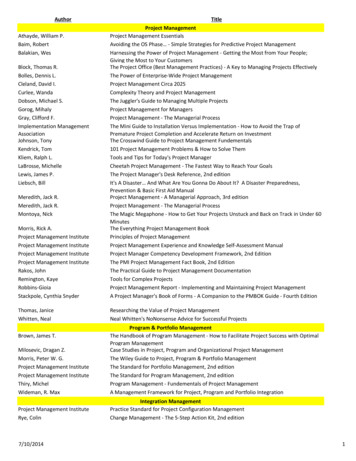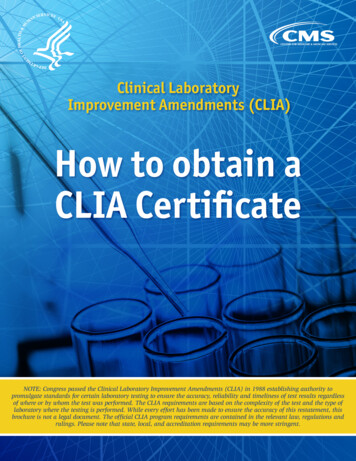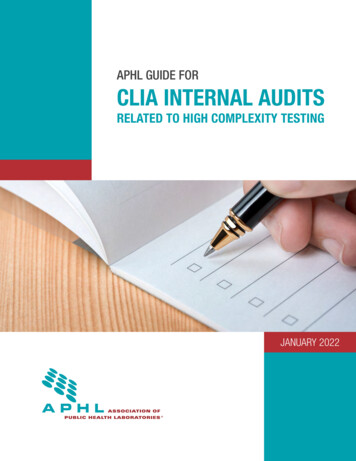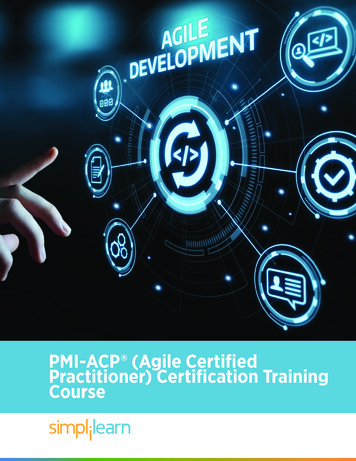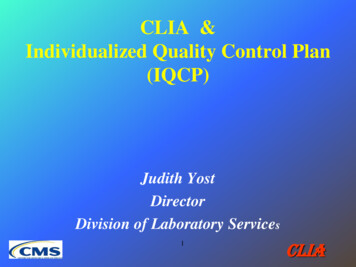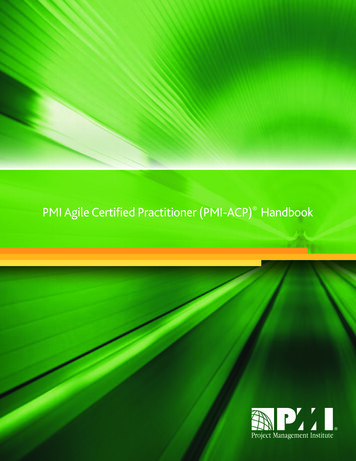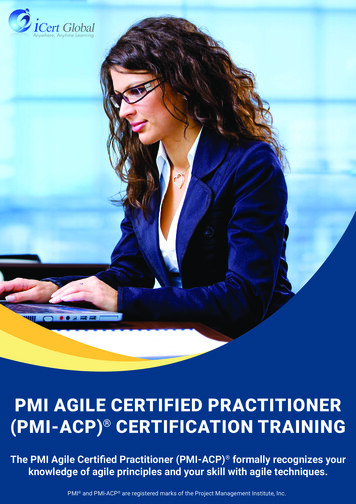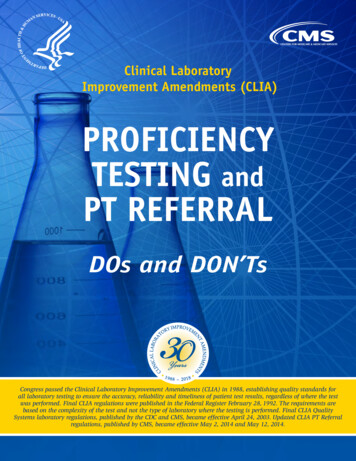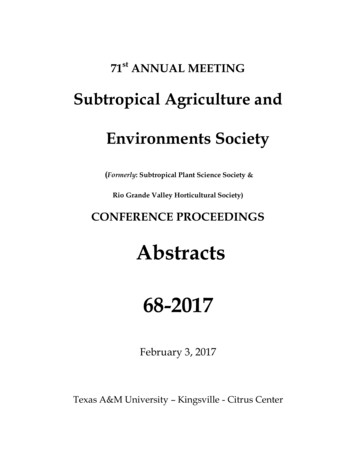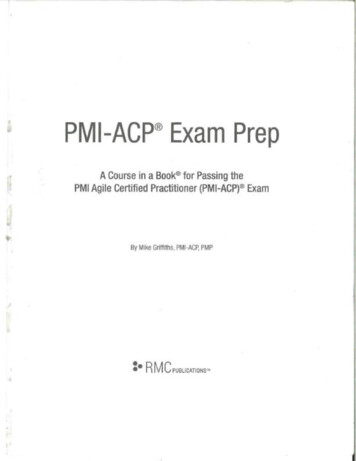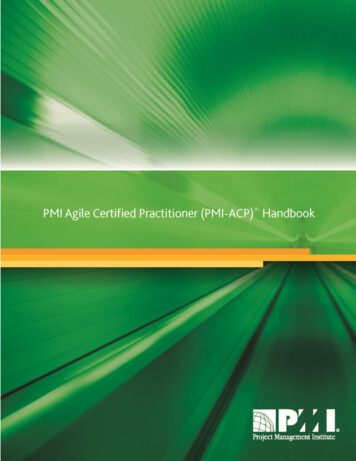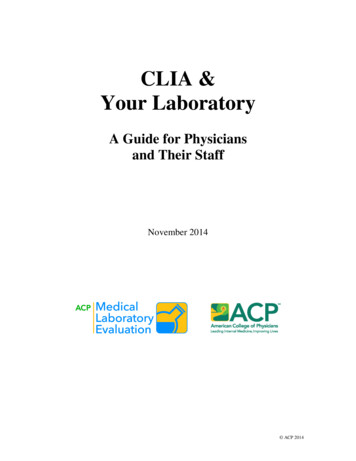
Transcription
CLIA &Your LaboratoryA Guide for Physiciansand Their StaffNovember 2014 ACP 2014
IntroductionThe American College of Physicians (ACP) welcomes your interest in this guide to theClinical Laboratory Improvement Amendments of 1988 (CLIA ’88). We hope that youwill find it helpful in answering many of your questions regarding regulations for clinicallaboratory testing.These CLIA regulations are far-reaching, and now regulate physician-office laboratory(POL) testing on a national scale. ACP originally published this guide in 1988. It hasbeen revised periodically to reflect the changes made to the regulations as a result of itsimplementation and ongoing modifications to CLIA. Among these changes are: The creation of a second moderate testing category A revised waived category Compliance measures for states that are CLIA-exempt Requirements for lab director certification for high-complexity labs An updated fee schedule for CLIA certificatesThis guide has been divided into nine chapters: The first chapter, “The Origin of CLIA ’88: An Overview,” traces thelegislative and regulatory history of CLIA ’88 and details some of its keycomponents. The second chapter, “The Implementation of CLIA ’88,” provides a stepby-step process for obtaining a CLIA certificate and the costs of the applicablecertificate. The third chapter, “Private-Sector and State Alternatives to FederalCertification,” explains how POLs can meet federal standards, by becomingaccredited by a nonprofit, private accreditation program, such as COLA or aCLIA-exempt state agency. The fourth chapter, “Waived, PPM, Moderate- and High-ComplexityTesting: How Will I Be Regulated?” details the four levels of regulation andthe testing that can be performed in each category, and the applicablestandards that must be met to comply with CLIA ’88. The fifth chapter, “The Proficiency Testing Requirements Under CLIA’88,” describes proficiency testing (PT) and the standards that physiciansowning non-waived laboratories must meet to comply with the CLIA PTrequirement. The sixth chapter, “Meeting the Quality Systems Standards,” details therequired quality control (QC) and quality assurance (QA) standards withwhich physicians owning laboratories must comply. This chapter alsoaddresses PT, test management and recordkeeping requirements.2 ACP 2014
The seventh chapter, “Complying with the CLIA Personnel Standards,”specifically outlines what testing personnel standards are needed to complywith the requisite moderate- and high-complexity testing personnel standards. The eighth chapter, “The Inspection Process,” details the process that is usedto ensure that POLs are meeting CLIA standards. This chapter also illustratesthe average cost of biennial inspections, and addresses the Alternative QualityAssessment Survey (AQAS) form. The ninth chapter, “The Enforcement of CLIA ’88,” details the enforcementprocedures and sanctions that the Centers for Medicare and Medicaid Services(CMS) may use to enforce the QA standards.This guide follows a question and answer format. We hope that we have addressed mostof your concerns about the laboratory regulations in this guide. ACP members may callour toll-free hotline at 800/338-2746, if they have additional questions about complyingwith CLIA ’88.ACP strives to assist its members in navigating the complex and often perplexingregulatory process. ACP has been a leader in reducing the regulatory burdens placedupon physicians who operate their own in-office laboratories. These initiatives include:reduced pre-billing time; the addition of a provider-performed microscopy category(PPM); the AQAS form, which is a written survey in lieu of an onsite inspection; revisedpersonnel requirements; active involvement in COLA’s expanded member services; andMedical Laboratory Evaluation—a PT program which operates as a part of ACP. All ofthese accomplishments have been made on behalf of the entire community of physicianswho operate in-office laboratories.Individual members of ACP benefit from the congressional advocacy provided by stafflobbyists and analysts. ACP staff also mediates with CMS staff and other federalofficials on behalf of ACP members’ individual concerns: ACP members do not have tonavigate regulatory territory alone. For specific questions about CLIA and yourlaboratory, call ACP at 800/338-2746.3 ACP 2014
Chapter 1The Origin of CLIA ’88: An OverviewSection 1.AThe Legislative History of CLIA ’881. How did the federal Quality Assurance (QA) standards for POLsoriginate?Before the enactment of CLIA ’88, only hospital and independent laboratorieswere required to meet the federal QA standards mandated by CLIA ’67. Congressfirst signaled its concern about the accuracy of POL testing by mandating—through the Omnibus Budget Reconciliation Act of 1987 (OBRA ’87)—that “highvolume” POLs meet the same Medicare standards as commercial laboratories. Itwas clear that Congress’ definition of high volume laboratories would haveincluded most POLs, and the task of writing such regulations fell to the Secretaryof the Department of Health and Human Services (HHS). By including this lastminute mandate into OBRA ’87, Congress made it clear that POLs no longerwould be exempt from federal QAs. Physicians and the laboratory communitywere forced to come to grips with the need for a workable approach to QA inoffice laboratories, and OBRA ’87 served as the “stick” to force such action.Following enactment of the OBRA ’87 provisions, media investigations intolaboratory practices caught the attention of Congress. Perhaps most notable was aPulitzer-prize winning series that was broadcasted by a Washington, D.C.,television station, and followed by a compelling article in the Feb. 2, 1987,edition of The Wall Street Journal that highlighted scandals involving severalcommercial laboratories which inaccurately analyzed Pap smears. Severalwomen died from undetected cervical cancer because of these inaccuratelyanalyzed tests. Of the tens of thousands of laboratories run by physicians at thattime, only a handful performed cytology testing, but the public demanded thatCongress take action in response to these preventable deaths. Congress reacted byholding oversight hearings which ultimately guided the drafting of CLIA ’88,which later was signed into public law (PL 100-578) on Oct. 31, 1988.The law isfar-reaching and regulates POL testing on a national scale.2. To whom does CLIA ’88 apply?CLIA ’88 applies to anyone who performs testing of human specimens for thediagnosis, prevention or treatment of disease or health problems. This includeseveryone from physicians performing the most basic tests (e.g., dipstickurinalysis) to the technicians working in POLs. The only exceptions are facilitiesthat perform testing for forensic purposes, research laboratories that do not reportpatient results, and facilities that are certified by the Substance Abuse and MentalHealth Services Administration (SAMHSA) to perform urine drug testing only.4 ACP 2014
3. What were Congress’ key objectives in enacting CLIA ’88?Supporters of CLIA ’88 believe that it was based on the best of intentions: toprotect patients from harm resulting from inaccurate testing. Additionally, the lawwas designed to assure that all laboratories were meeting reasonable qualitystandards that recognized the different levels of complexity of tests typicallyperformed in POLs. Drafters of the law tried to design CLIA ’88 so that theregulations would be workable and cost-effective, without jeopardizing access toin-office testing. CLIA ’88 established requirements to improve the quality oflaboratory testing, including standards for the performance of Proficiency Testing(PT), Quality Control (QC), QA, patient-test management and personnelrequirements.4. What has been the effect of the CLIA ’88 legislation?CLIA ’88 had a significant adverse impact on the quality and accessibility of POLtesting. Specifically, the CLIA regulations have affected the types of tests physicians noware willing to offer in their office labs. To avoid the costs associated with CLIAregulations, many physicians discontinued valuable in-office testing in the moderate-andhigh-complexity categories. The prompt receipt of such test results and the capability toevaluate specimens directly are useful to the physician and help to expedite decisionsabout appropriate patient care. As a result, patient’s access to timely quality testing hadbeen compromised.According to a 1995 survey performed by the American Medical Association (AMA) andsix other specialty groups, 63.3 percent of POLs had “scaled back or completelyeliminated laboratory testing” since the provisions took effect in 1988. Similarly, of thosethat scaled back or eliminated their in-office testing, 81 percent reported an increase inthe time needed for patient diagnosis and treatment onset. Eliminating in-office testinghas seriously affected patients in rural areas who travel an average of 15 miles tolaboratory testing sites. Furthermore, the survey found that some patients were obtainingmore costly care in emergency room settings than in the laboratories referred by theirphysicians.However, since that time, hundreds of tests have been approved for the waived categoryand over 100,000 POLs exist today. The CLIA ’88 regulations were rewritten in 2003,and more than a decade of familiarity with them has encouraged many physicians tocontinue or start up a laboratory within their practice.5 ACP 2014
Section 1.BThe Rule-Making Process1. Who is responsible for the implementation of the law?Like most laws, the responsibility of implementation of CLIA ’88 fell to a federalagency. In this case, Congress delegated to CMS—in consultation with theCenters for Disease Control and Prevention (CDC)—the responsibility oftranslating legislative intent into workable regulations and then enforcing thoseregulations.Unfortunately, many components of CMS’s attempts to translate and enforce theregulations have been unacceptable. Its first proposal in 1990 included regulatoryclassifications that would have placed most POLs in the same level of complexityas commercial laboratories conducting the most sophisticated testing available—thus requiring them to meet unacceptable and unworkable personnel standards.This proposed rule would have put most POLs out of business. The proposalconflicted with Congress’ intent to recognize the different levels of testingcomplexity typically performed in office laboratories, and to preserve patientaccess to in-office testing. Clearly, the proposed regulation had to be changedsubstantially.In 1992, CMS published its final rules on the administrative process, qualitystandards, fee collection and enforcement of CLIA. ACP offered suggestions toCMS on each of these components to make CLIA less burdensome; unfortunately,many suggestions were not incorporated into the final rule. However, ACPcontinues to work with CMS officials to alleviate unnecessary burdens placed onPOLs.Although CLIA ’88 regulations became effective Sept. 1, 1992, regulationsgoverning Provided Performed Microscopy (PPM) and PT did not becomeeffective until Jan. 1, 1993, and Jan. 1, 1994, respectively. Since then, the testingcategorizations have been revised on several occasions. The most recent changewas when the Quality Standards section of the regulation was streamlined andrewritten.6 ACP 2014
Section 1.CSummary of the Final CLIA ’88 Regulations1. What are the key elements of the final CLIA ’88 regulations?CLIA imposes standards for laboratory personnel, patient-test management, PT,QC and QA. The rule also imposes application procedures, fees for certification,enforcement and sanctions. The key elements are summarized briefly below.Laboratories performing moderate- and high-complexity testing must undergobiennial inspections conducted by CMS or a private accreditation organization.More detailed explanation of each can be found in later chapters of this guide.CMS considers both the volume of testing and the number of specialties (e.g.,bacteriology) being tested when determining the biennial inspection fees thatlaboratories will be charged (see Chapter 8).A. Under the final rule, CLIA requires moderate- and high-complexitylaboratories to participate in three PT events per year. Five challenges(defined as the number of samples that must be tested per analyte) arerequired per PT event for most testing. CLIA required laboratories tobe enrolled in an approved PT program as of Jan. 1, 1994; in 1995,CMS began to impose sanctions for those not enrolled (see Chapter 5).B. The QC requirements include control and calibration requirementsapplicable to both moderate and high complexity labs. As of Jan. 1.1994, QC requirements have been mandatory for all laboratories.C. The QA and patient-test management requirements refer to thecomprehensive, ongoing process of monitoring and evaluating everystep of the laboratory’s testing process—including patient preparationand specimen collection, test analysis and test-result reporting. Eachlaboratory performing nonwaived testing must establish and followwritten policies and procedures for a comprehensive QA program thatis designed to monitor and evaluate the ongoing and overall quality ofthe total testing process. (The QA requirements are described inChapter 6.)D. The personnel requirements for moderately complex laboratories areoutlined in detail in Chapter 7.B.There are four personnel functionsthat must be fulfilled in a moderately complex laboratory, including: The director, who is responsible for the overall administrationof the laboratory; The technical consultant, who is responsible for the technicaland scientific oversight of the laboratory and must be availableon an as-needed basis; The clinical consultant, who serves as liaison between thelaboratory and its clients in matters related to reporting and7 ACP 2014
interpreting results; and Testing personnel, who are responsible for processing thespecimens and reporting results.E. The personnel standards for highly complex laboratories havemodified the qualifications required for directors and supervisors ofhigh-complexity labs. There are five functions that must be fulfilled,including: The director; A technical supervisor; A general supervisor; A clinical consultant; and Testing personnel8 ACP 2014
Chapter 2The Implementation of CLIA ’881. Who must apply for a CLIA ’88 certificate?Anyone who performs testing of human specimens for the diagnosis, prevention ortreatment of disease or health problems must apply for a CLIA certificate. Thisincludes physicians who operate their own in-office laboratories. In fact, 2007CMS statistics show that POLs constitute 52.9 percent of all CLIA-certified labs.Independent laboratories and others make up the remainder. A separateapplication must be filed for each laboratory location. However, laboratoriesowned by the same entity, located in the same building and sharing the samelaboratory director only need to apply for one certificate.2. Do I have to apply for a CLIA certificate even if I am only performinga few simple tests in my office?Yes. CLIA regulations apply to all laboratory testing used to assess human healthor to diagnose, prevent or treat disease (even those very basic tests performed aspart of a physical examination—including fecal occult blood or dipstickurinalysis—are subject to CLIA ’88).These simple tests, which fall in the waivedcategory, are exempt from specific CLIA requirements, such as PT participation,personnel requirements and biennial inspections that apply to moderate- and highcomplexity tests. The only requirements that physicians performing waivedtesting must meet are to apply for a certificate of waiver every two years andfollow the manufacturer’s instructions including all that relate to QCperformance. A description of how to access a complete list of waived tests isincluded in Appendix C.3. Do I have to apply for a CLIA certificate if I am not billing Medicarefor laboratory testing?Yes. Physicians with in-office laboratories must apply for a CLIA certificateregardless of whether they are billing Medicare. CLIA ’88 is intended to ensurequality testing for all patients, not just Medicare beneficiaries.4. What should I do first?Any physician wishing to perform laboratory tests either waived or non-waivedmust fill out a “CLIA Application for Certification” – Form CMS-116. This formmay be obtained by contacting your State Agency (see Appendix A) ordownloaded from the CMS website at www.cms.hhs.gov/clia and click on the link“How to Apply for a CLIA Certificate, Including Foreign Laboratories” Afterfilling out this form it should be submitted to the local CLIA State Agency forprocessing. A fee remittance coupon and CLIA number will be returned from theState Agency. A formal certificate will be issued upon remittance of the9 ACP 2014
appropriate fee. Non-waived, non-PPM laboratories will receive a Certificate ofRegistration if this is an initial application. This will allow the laboratory to billfor testing performed prior to the initial on-site survey by either the State Agencyor an approved accreditation body.5. What is the cost of a Certificate?There are four types of certifications: Certificate of Waiver, Provider PerformedMicroscopy (PPM) Certificate, Certificate of Compliance, and Certificate ofAccreditation. The fee for a Certificate of Waiver is 150 and the fee for a PPMCertificate is 200. Each certificate is issued for a two-year period. For nonwaived, non-PPM laboratories, the fee for the initial Certificate of Registration is 100. After a laboratory is successfully inspected, either by a State Agency or byan Accreditation body, the Certificate of Compliance or Certificate ofAccreditation will be issued. The fee schedule for these two certificates is thesame and based upon the volume of tests performed in the laboratory. Thisschedule can be found at the end of this section, in a table called CLIA CertificateFees. Fees for the inspection are separately billed by either CMS or yourAccreditation body.6. What is the cost of an inspection performed by CMS?The federal government has negotiated rates for inspection with each State SurveyAgency. There is a separate inspection fee schedule for each state. The feeschedule is based upon the same testing volume categories as the Certificate fee.Contact your State Agency for a copy of the inspection fee schedule for yourstate.7. What are my rights if my application for a registration certificate isdenied?If CMS denies your laboratory’s application for a registration certificate, acertificate of waiver, a certificate of accreditation, or limits the laboratory’scertificate, the agency must give the laboratory a statement of the grounds onwhich the denial or limitation is based, and an opportunity to appeal. Thelaboratory cannot operate legally as a laboratory unless the limitation or denial ofa specified certificate is overturned at the conclusion of the administrative appealsprocess. Contact ACP for assistance if you encounter this problem.8. When can I expect an inspection?Except for waived and PPM laboratories, all laboratories must be inspected. CMSrandomly selects laboratories for inspections every few weeks. Following aninspection, laboratories will receive the appropriate “certificate” or a “certificateof accreditation” (a certificate of accreditation will be issued to those laboratoriesthat are seeking accreditation by a CMS-authorized accrediting body).This10 ACP 2014
certificate is renewable every two years. In states with federally approvedlicensure programs, a laboratory may obtain a state license in lieu of a federalcertificate. If your laboratory is located in a state with its own federally approvedQA program for laboratory testing, you will have to meet state standards only.See Chapter 3 for information about nonprofit, private accreditation programs—such as COLA—and state-exempt licensure programs.9. What if the location or ownership of my laboratory changes?A laboratory owner is required to notify CMS within 30 days if a change occursin the ownership, name and/or location of the laboratory. Laboratories also mustnotify CMS within 30 days if the director or supervisor changes. Facilitiesrequesting a revised certificate must pay a modest fee to cover the costs of issuinganother certificate.10. What if I change my testing menu?In most instances, CMS will not require laboratories that add a new test or tests totheir testing menu to obtain a revised certificate before they begin the new testing.Rather than list analytes approved for testing, the laboratory’s certificate willspecify the specialties and subspecialties of testing (e.g., bacteriology) for whichthe laboratory is certified. Provided the test additions are included in the specialtyor subspecialty for which the laboratory is certified, CMS will not require thelaboratory to obtain a revised certificate. The lab will, however, be required tonotify the agency of changes in its testing menu within six months. If the test isnot in the specialty or subspecialty listed on the lab’s certificate, CMS mayconduct a survey to determine compliance with CLIA standards. A laboratorywith a certificate of waiver must notify CMS before performing tests not on thewaived list; CMS then will authorize a restricted registration certificate for thenew services, granting permission for the laboratory to initiate new testing until itdetermines whether the laboratory meets CLIA standards.Laboratories issued a certificate of accreditation (e.g., those labs participating inan approved, private, nonprofit accreditation program), must notify theaccreditation program within six months of performing any test or examinationwithin the specialty or subspecialty area that is not included in the laboratory’saccreditation. Laboratories also must notify the accreditation program within sixmonths of making any deletions or changes in the test methodologies for any testor examination included in a specialty, subspecialty or both, for which thelaboratory has been issued a certificate of accreditation.Laboratories increasing the volume or scope of testing may increase additionalfees for re-certification. Contact your CMS regional office or State HealthDepartment for further information. Currently, there is a charge of 75 to labs thatneed to re-certify on this basis. There is no fee reduction (during your currentcertification period) for decreasing the volume or scope of testing.11 ACP 2014
CLIA Certification FeesWaiverPPMFee Summary 150 200CLIA Certificate FeesType of LabWaivedPPMLow Volume ASchedule ASchedule BSchedule CSchedule DSchedule ESchedule FSchedule GSchedule HSchedule ISchedule JNumber ofspecialtiesN/AN/AN/A3 or fewer4 or more3 or fewer4 or moreN/AN/AN/AN/AN/AN/AAnnual test volumeN/AN/ALess than 01-500,000500,001-1,000,000Greater than 1,000,00012Biennialcertificate fee 1502001501501504304406501,1001,5502,0406,2207,940 ACP 2014
Chapter 3Private-Sector and State Alternatives toFederal CertificationSection 3.APrivate-Sector Alternatives to Federal Certification and Inspections1. What are private, nonprofit, accreditation programs, such as COLA?CMS has approved several private, nonprofit, accreditation programs. Theseprograms are offered by COLA (which is specifically tailored to the POLenvironment), the College of American Pathologists, the American Association ofBlood Banks, the American Society for Histocompatibility and Immunogenetics,the American Osteopathic Association, and The Joint Commission. Theseorganizations are responsible for helping your laboratory meet the federalrequirements set forth in CLIA. ACP strongly recommends that physician-ownersof in-office laboratories enroll in COLA. ACP members who have enrolled inCOLA experience fewer hassles and feel less of a bureaucratic burden than thosewho do not.2. What is COLA?COLA is a voluntary education and accreditation program that reflects the effortsof specialists in laboratory medicine and office-based physicians to assure thatoffice-based testing produces high-quality results. ACP co-founded COLA withthe College of American Pathologists, the American Academy of FamilyPhysicians, and the American Medical Association. The American OsteopathicAssociation later joined COLA’s governing board.3. What advantages will physicians-owners of in-office laboratories reapfrom participating in COLA, as opposed to seeking federal certification?Unlike the CMS-certification program, COLA has indicated that it will providethe following services to laboratories participating in the program: The opportunity to conduct a comprehensive self-inspection using thesame criteria as COLA inspectors, to prepare for the survey. An evaluation of the self-inspection and a report of deficiencies thatshould be corrected before the onsite inspection. Well-trained inspectors to assist laboratory staff and to offersuggestions, hints and advice to improve your laboratory’sperformance. Up to 15 hours of Category 2 continuing medical education (CME)credit for physicians participating in the COLA program. An expert staff of medical technologists offering toll-free telephoneassistance. Timely information regarding all office-laboratory regulations,13 ACP 2014
including CLIA, the Stark amendments, Occupational Safety andHealth Administration (OSHA) and others. Concise articles on various aspects of office laboratory practice—articles that are easily understood and that provide specific informationto solve problems. The articles may be received via fax the same daythe request is made.COLA’s fee schedule is competitive with the cost of federal certification. Additionally,COLA offers many added services (listed above) that the federal government does nothave the resources to provide. ACP members should note that privately accreditedlaboratories are included in CMS’s random 5 percent validation survey of accreditedlaboratories.COLA also offers ACP members discounts and will pay any switching fee from CMS forthe POL. Additional discounts can be obtained by using ACP’s Medical LaboratoryEvaluation (MLE) program in conjunction with COLA.4. How can I find out more about COLA?Contact COLA at the following location and phone number:COLA9881 Broken Land Parkway, Suite 200Columbia, MD 21046800/981-988314 ACP 2014
Section 3.BState-Exempt Licensure Programs for Laboratories1. What if my POL already is regulated by the state?Some states already regulate POLs. According to CLIA ’88 regulations, labs areexempt from CLIA’s requirements (and therefore, do not need to apply for federalcertification, pay any federal certificate fees, or undergo routine, federal, biennialinspections) if they are located in states that have licensure and inspectionprograms approved by CMS. In these cases, the lab must comply with statestandards, which must be equal to or more stringent than the federal CLIArequirements, to renew exemption status.2. What states currently are CLIA-exempt? Washington and New York (not including POLs).3. What states now impose additional regulations on POLs?The following states impose additional rules on POLs, over and above federalregulations: Arizona (has a comprehensive program that regulates all POLs). California (has a comprehensive program that regulates all POLs). Connecticut (state law requires all POLs to have a state license). District of Columbia (requires D.C. licensure of in-office testing). Florida (requires state licensure of in-office testing). Louisiana (requires state licensure of in-office testing). Maine (regulates POLs performing referral testing only). Maryland (has a comprehensive program that regulates all POLs). Massachusetts (regulates group practices with three or morephysicians). Michigan (only regulates group-practice laboratories with six or morephysicians doing patient or referral testing). Nevada (requires state licensure of all in-office testing). New Jersey (group practices with five or more physicians operatinglaboratories must meet independent laboratory standards). Oregon (requires state licensure of in-office testing). Pennsylvania (has a comprehensive program that regulates all POLs). Washington (has a comprehensive program that regulates alllaboratories). Puerto Rico (requires state licensure of in-office testing and alsorequires physicians to prove laboratories are “necessary” prior toobtaining permission to run an in-office laboratory).15 ACP 2014
Chapter 4Waived, PPM, Moderate- and High-ComplexityTesting: How Will I Be Regulated?Section 4.AWaived Tests1.What are the criteria for waived testing?The Centers for Disease Control and Prevention (CDC) performed thedetermination of waiver for tests until January 2000, after that time the Food andDrug Administration (FDA) took over this function. Under the current process,waivers may be granted to : 1) Any test listed in the regulation; 2) Any test systemfor which the manufacturer or producer applies for waiver if that test meets thestatutory criteria and the manufacturer provides scientifically valid data verifyingthat the waiver criteria have been met; and 3) test systems cleared by the FDA forhome use. The statutory criteria include 1) they employ simple yet accuratemethodologies rendering the likelihood of erroneous results negligible; and 2)they pose no reasonable risk of harm to the patient if performed incorrectly.2.What tests are on the waived list?As of February 6, 2008, the FDA (or CDC) has granted waived status to at leastone test system for each of 110 separate anlaytes. The FDA maintains a list ofthese analytes with links from each analyte to a listing of the test systems waivedfor that analyte A/analyteswaived.cfm. Itwould be wise to check this listing prior to
The first chapter, "The Origin of CLIA '88: An Overview," traces the legislative and regulatory history of CLIA '88 and details some of its key components. The second chapter, "The Implementation of CLIA '88," provides a step- by-step process for obtaining a CLIA certificate and the costs of the applicable
